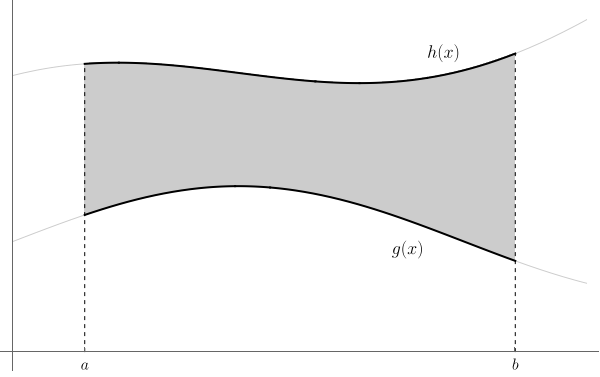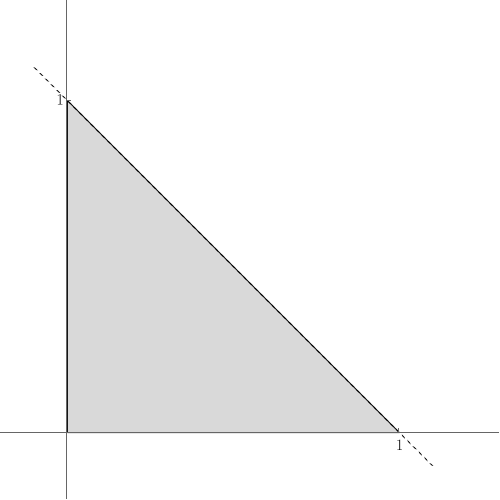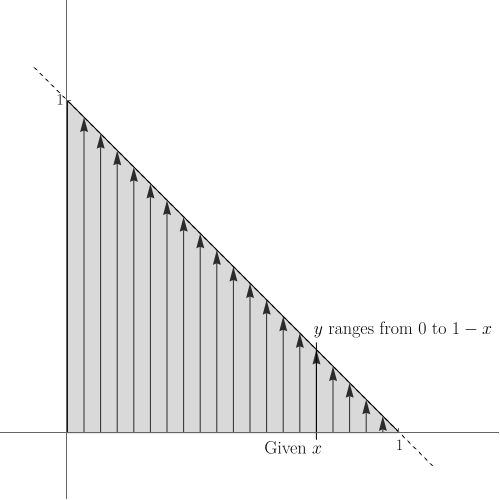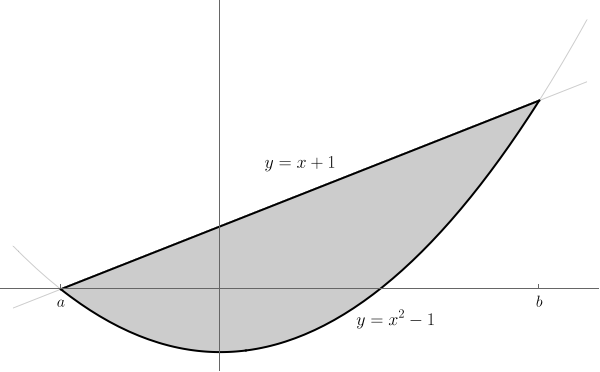Other regions
Last time, we met the concept of a double integral which allows us to compute the volume under the graph of a function $f:\mathbb R^2 \to \mathbb R$ and over a rectangle in the $xy$-plane. Today, we'll discuss what happens if we want to find the volume over some other shape.
Illustration
The image below illustrates the basic situation. This picture plots the same function as this one from our last presentation but now we are interested in the volume over a triangle, rather than over a rectangle.

Describing regions
In order to integrate over more general regions we'll need to generalize each of the following from our last presentation:
A more general domain
$$\{(x,y): a \leq x \leq b, g(x) \leq y \leq h(x)\}$$
Bounds
Again, the bounds of the region
$$\{(x,y):\color{red}a\leq \color{green}x \leq \color{red}b, \color{red}{g(x)}\leq \color{green}y \leq \color{red}{h(x)}\}$$correspond to the bounds of integration
$$\int_{\color{red}a}^{\color{red}b} \int_{\color{red}{g(x)}}^{\color{red}{h(x)}} f(x,y) \, d\color{green}y \, d\color{green}x.$$Example
Evaluate $\iint_R (1-(x^2+y^2)) \, dA$ where $R$ is the region shown below:

Example (cont)
The diagonal line has equation $y=1-x$. Thus, we could describe the region as
$$\{(x,y): 0<x<1, 0<y<1-x\}.$$
Example (cont 2)
To set up the integral, it's important to understand that (given our description) we'll integrate with respect to $y$ first:
$$\int_0^1 \int_0^{1-x} (1-(x^2+y^2)) \, dy \, dx.$$Example (cont 3)
As before, we integrate from inside out.
$$ \int_0^1 \color{red}{\int_0^{1-x} (1-(x^2+y^2)) \, dy} \, dx = \int_0^1 \color{red}{\left(y - x^2y-\frac{1}{3}y^3\right)\Big|_0^{1-x}} \, dx \\ = \int_0^1 \color{red}{\left((1-x) - x^2(1-x) - \frac{1}{3}(1-x)^3\right)} \, dx \\ = \int_0^1 \left(\frac{4 x^3}{3}-2 x^2+\frac{2}{3}\right) \, dx = \frac{1}{3}. $$Reversing order
Often, an integral can be evaluated in either order - $y$ first, then $x$ OR $x$ first, then $y$. This basically, boils down to an alternate description of the domain. For example, the previous domain could be described as:
$$\{(x,y): 0<y<1, 0<x<1-y\}$$instead of originally:
$$\{(x,y): 0<x<1, 0<y<1-x\}.$$Reversing order (cont)
$$\int_0^1 \int_0^{1-y} (1-(x^2+y^2)) \, dx \, dy.$$
Order matters
Suppose we'd like to set up the following integral over the domain shown below:
$$\iint_D f(x,y) \, dA, \text{ where }D\text{ is}$$
Order matters (cont)
First, we need to determine $a$ and $b$ by solving $x+1=x^2-1$. You should find that $x=-1$ or $x=2$. Then, you need to set up the integral with respect to $y$ first to get:
$$\int_{-1}^2 \int_{x^2-1}^{x+1} f(x,y) \, dy \, dx.$$Order matters 2
Suppose we'd like to integrate
$$\int_0^1 \int_y^1 e^{-x^2} \, dx \, dy.$$Note that the inner integral is essentially impossible. In this case, the order of integration is dictated by the function.
Order matters 2 (cont)
As set up, we're trying to integrate with respect to $x$ first

Order matters 2 (cont 2)
Let's try to integrate with respect to $y$ first.
